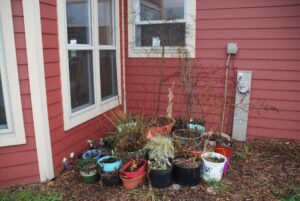As you prepare your landscape for winter don’t overlook the trees, shrubs and perennials you have growing in containers. These need a bit of extra protection to help them survive cold winter temperatures.
The small amount of soil in container gardens does not always provide sufficient insulation. The roots are more exposed to temperature extremes than those of their counterparts growing in the ground. Extremely cold temperatures can damage or kill the roots and even the plant.
Plants rated at least one zone hardier than your zone can usually survive when left outside for winter. Just make sure your containers will also tolerate the challenging winter weather.
Here are a couple strategies for helping your other containers through the winter. Select the one that best fits your landscape space and gardening style. Those in apartments or with limited space may need to enlist the help of their gardening friends.
 Move containers to a sheltered location. Place them close together for added insulation. Then surround this with annual pots of flowers and vegetables to further insulate the roots. Wait until spring to empty and compost the annual plants. Or cover the pots with woodchips or surround them with bags of leaves, potting mix or bales of straw. Add another layer of insulation by piling snow that is free of deicing salt over the pots throughout the winter.
Move containers to a sheltered location. Place them close together for added insulation. Then surround this with annual pots of flowers and vegetables to further insulate the roots. Wait until spring to empty and compost the annual plants. Or cover the pots with woodchips or surround them with bags of leaves, potting mix or bales of straw. Add another layer of insulation by piling snow that is free of deicing salt over the pots throughout the winter.
Any plants growing in nursery pots or plastic containers can be overwintered in a vacant section of the garden. Sink the pots in the ground and make sure the pot is covered with and surrounded by soil. Water if needed. Then lift the plants in spring and set them in a decorative container to enjoy throughout the growing season.
An unheated garage also provides a suitable location for overwintering container gardens. Heated garages are usually too warm and plants will begin to grow. With a lack of sufficient sunlight, they usually struggle through the winter and often die.
Place the plants away from the overhead garage door. Add a bit of insulation such as packing materials, bagged soil or other potential insulation you probably have in your home or garage. This protects the roots when the temperatures plummet.
Water your stored containers whenever the soil is thawed and dry. A scoop of snow that is free of deicing salt works well. Just toss a scoop on each pot. When the temperatures rise the snow melts and waters the pots. Dry soil during a winter thaw is the usual cause of death when pots are stored this way.
If space allows, you may decide to plant those trees, shrubs and perennials growing in containers into the garden each fall. You will eliminate this overwintering task and have a great excuse for buying new plants next spring.
Melinda Myers is the author of more than 20 gardening books, including Small Space Gardening. She hosts The Great Courses “How to Grow Anything” DVD series and the nationally-syndicated Melinda’s Garden Moment TV & radio program. Myers is a columnist and contributing editor for Birds & Blooms magazine and her web site is www.MelindaMyers.com.
